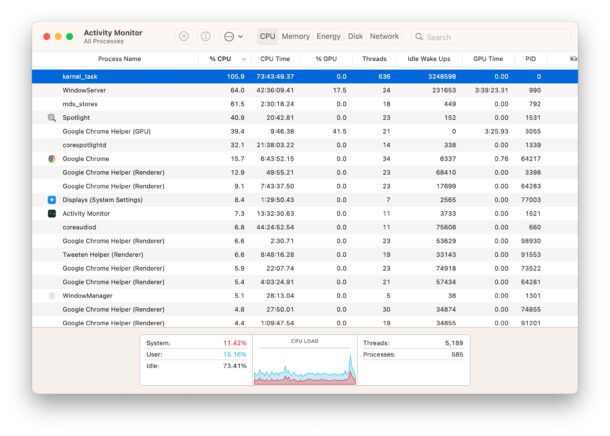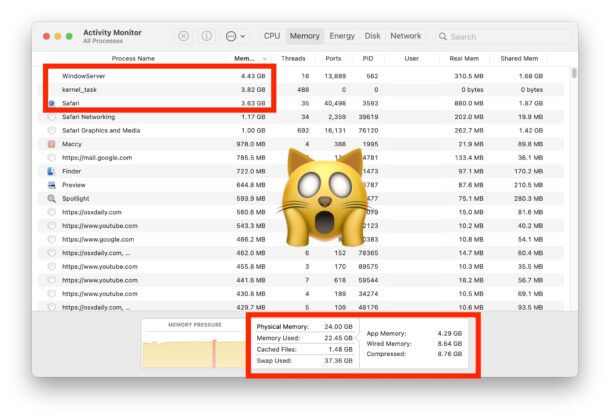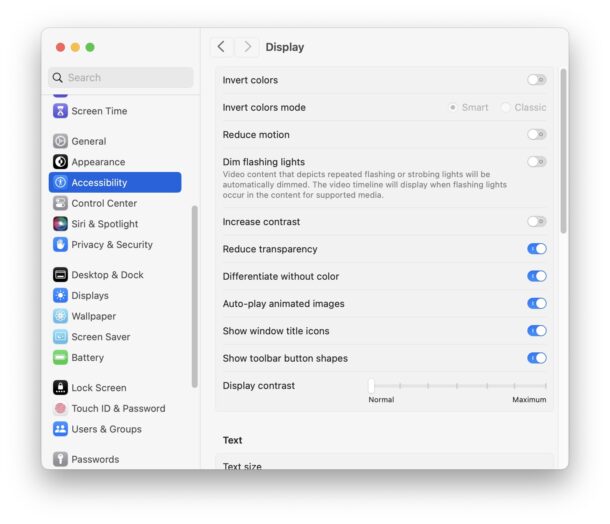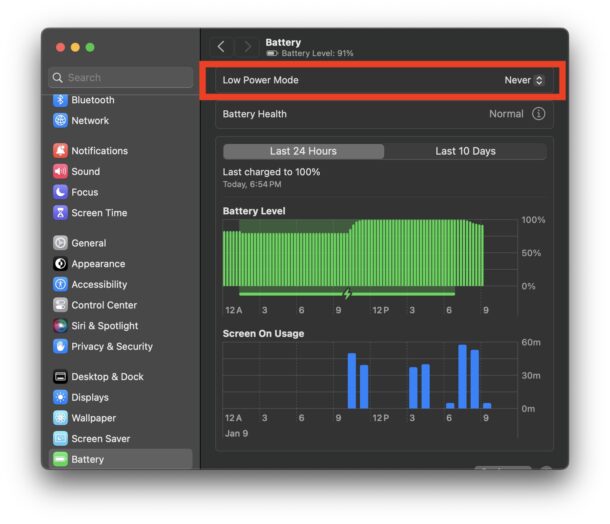Slow Performance in MacOS Sonoma? Fix Sluggish Speed on Mac

MacOS Sonoma is a perfectly great operating system for most Mac users, and many feel its variety of features and general enhancements offer improvements over its predecessor. However, not all MacOS Sonoma users are thrilled, and some people feel their Mac is slower after updating to MacOS Sonoma 14, experiencing more sluggish general performance, unresponsiveness to some apps, seeing more beachballs and wait cursors, and just a general perception that their computer is now slower.
If you are experiencing performance issues with macOS Sonoma and feel like your Mac is slower since updating, take a look a these tips to correct the problem.
1: Just Updated? Be Patient While MacOS Indexes
If you literally just updated to macOS Sonoma, or installed a major macOS Sonoma system update, then have some patience, because MacOS tends to perform a lot of background tasks and re-indexing when a major system software update has been performed.
If you just recently upgraded to Sonoma from Ventura, Monterey, or earlier, then the indexing tasks can take a while, sometimes even a few days, depending on how much stuff you have and the speed of the Mac and its disks.
The solution to this is pretty straightforward; leave the Mac turned on, but unused, and all the routine tasks will be finished in time, resulting in system performance returning to it’s typically speedy self.
2: Install Available System Software Updates
If you updated to an initial version of macOS Sonoma, for example MacOS Sonoma 14.0, and you find performance to be subpar, don’t forget to install available system software updates, for example, macOS Sonoma 14.3.1 because macOS Sonoma receives regular updates for bugs and security, and often those bug fixes will result in performance improvements.
You can check software updates for Sonoma by going to Apple menu > System Settings > General > Software Update.

3: Running tons of apps at once?
If you are running a very heavy workload on your Mac, including a bunch of simultaneous apps, and web browsers with multiple dozens of browser tabs open at once, your Mac is going to perform slower than when running fewer apps at the same time.
Quit out of any unnecessary applications for your current workflow, and performance should increase for the other apps, and macOS Sonoma in general.
This is particularly true if your have a MacBook Air, MacBook Pro, iMac, or Mac Mini with 8GB RAM, but many professional workflows will run into performance issues with 16GB RAM, 24GB RAM, or even 32GB RAM. Sure, Apple Silicon is very efficient and speedy, but RAM is RAM, and the more RAM you have, the better your Mac will perform, it’s still that simple.
4: Quit Out of Messages
The Messages app is a fantastic way to communicate with people, but some macOS Sonoma users report that Messages can slow a Mac by using large amounts of CPU, and simply quitting out of Messages tends to resolve the related speed issues.
Often the slowness is because Messages is syncing across devices or iCloud, or because an animated GIF or a bunch of stickers are in an active messages conversation thread, but whatever the reason, if it’s slowing down your Mac, quitting the app will speed up your computer again.
![]()
This could be a bug or issue that gets resolved in a future macOS update, so don’t forget to install any available updates.
5: Use Activity Monitor to Discover Performance Hogs
Sometimes, a Mac runs slow because there is an errant process, or an app going wild and using an inordinate amount of system resources, grinding the entire machine to a halt.
Open Activity Monitor (/Applications/Utilities/ folder), and click on the “CPU” tab to sort by CPU usage. Next, go to the “View” menu and choose “All Processes”. If you see something at the very top using a large % of CPU, you’ve likely found your culprit, or perhaps a lead, as to why the Mac is running slow. You can also sort by Memory to discover things consuming your RAM.
For example, you may see WindowServer using a large amount of CPU, but the easiest way to reduce WindowServer CPU and RAM usage is by having fewer windows open, since each open window takes system resources to keep in memory and draw on the screen.

You might also see kernel_task using up huge amounts of resources, which is often a sign the Mac is swapping excessively (ie; using virtual memory, having run out of available system memory), or performing some under-the-hood activity.
Sorting by “Memory” and you might also find excessive memory usage by some apps, and even some system processes, and even Macs with large amounts of physical RAM can quickly run out of available memory which grinds the computer to a crawl. The only real solution to slow performance due to memory usage is to close unnecessary windows and apps, and run fewer apps concurrently.

The screenshot shown here is from an M2 Mac with 24GB RAM that was in a constant state of beach balling and running so slow – even with typing lagging as if you were on a 2400bps dialup modem – you would think it was a constrained virtual machine running Sonoma on ancient old chip, but in fact this is a brand new Mac that despite having 24GB RAM has run out of memory and is maintaining a 37GB(!) swap file, grinding the computer to a near halt. When WindowServer and kernel_task are using this much memory and performance is this slow, your only option is to quit some running apps and close windows/tabs in some apps (in this case, Safari is using huge amounts of memory as well, suggesting too many Safari windows/tabs is the culprit). Rebooting the Mac after a situation like this also will speed things up by clearing out memory and caches.
If you see something that is red and “Not Responding” you could force quit that process, or kill it within Activity Monitor, and that will likely free up system resources too.
6: Keep the Mac Desktop Cleaned Up
Many Mac users desktops are a mess of files and folders, and this can also slow performance on a Mac because each desktop icon takes up resources to draw on the screen.
There are two super simple solutions to this; use Stacks, and/or create a new folder on the desktop called something like “Desktop Stuff” and drag everything from the Desktop into that folder. Either of these approaches will reduce the amount of resources taken up by having a busy desktop full of stuff.
7: Turn Off Window Transparency
Disabling the window transparency effect can offer a little boost to performance, particularly on older Macs or those with less RAM, since drawing that effect consumes system resources.
Go to > System Settings > Accessibility > Display, and switch the setting for “Reduce Transparency” to be enabled.

This will subtly change the appearance of windows on the Mac by making them not transparent, and also can potentially increase speed a bit for some Macs. You may even notice some animations feel a bit faster since the windows do not have to draw any transparency effects, like the one for clicking the wallpaper to show the desktop that pushes aside all open windows.
8: Backup with Time Machine, Install macOS Sonoma, Restore from Backup
If you’re Mac is absolutely struggling with performance, feels very slow, and is almost unusably sluggish with macOS Sonoma, another extreme option is this; backup, erase the Mac, and restore the Mac from your backup.
This is kind of an extreme last resort, but it tends to restore performance if something is awry with the system installation itself. If system performance is slow due to usage and system resource constraints, this won’t help much, however.
It is essential that you backup your Mac with Time Machine so that you do not lose any personal files or data before doing this.
You can also try a less invasive method of simply reinstalling macOS Sonoma on the Mac, which replaces only the system software, but that doesn’t always achieve the same result.
9: Clicking in macOS Sonoma Feels Slow or Unresponsive?
A separate issue that some users have reported with macOS Sonoma involves the mouse/trackpad and it’s cursor, with some users experiencing mouse clicking issues with the system software version. This is not a speed issue directly, but the unresponsive clicks can make it feel like the Mac is slower, when in fact it’s a separate circumstance related to clicking behavior and not the performance of the operating system itself.
10: Optimize Mac Gaming Performance with Game Mode
One significant area of performance improvement in MacOS is with gaming, thanks to the new Game Mode feature in MacOS Sonoma.
Remember, Game Mode activates automatically in macOS Sonoma, so the only thing you have to do is run a game in full-screen mode to prioritize that app and performance.
The running games in full-screen mode thing is important, because if you run a game in windowed mode, Game Mode will not activate. Put the game into Full Screen, and you’ll quickly notice the performance boost when gaming on a Mac.
11: MacBook Air/Pro Feels Slow with Sonoma? Disable Low Power Mode
Low Power Mode is a fantastic feature that can potentially extend the battery life and runtime of your Mac laptop, but it does so by reducing system performance rather dramatically.
You can turn off Low Power Mode on a MacBook Pro or MacBook Air by going to System Settings > Battery > and toggling the setting for Low Power Mode to the ‘Never’ position.

This setting alone can fix slow performance on MacBook Air and MacBook Pro computers. You may lose an hour or so of battery life, but in exchange for a boost in performance by up to 40%, which is significant!
–
Are performance complaints about macOS Sonoma common?
Every MacOS release tends to have associated complaints about performance, though for the majority of users they are easily resolved simply by waiting a few hours (or days) for the Mac to reindex data.
Nonetheless, reduced performance and slow speeds are amongst the most
common complaints about performance with any new MacOS version, Sonoma included, and those complaints are easily found on Apple’s own Discussion Support forums, as well as enthusiast sites like Reddit, MacRumors Forums, Twitter/X, and elsewhere.
Does macOS Sonoma feel slow to you? Or is performance better?
How do you feel about the speed and performance of macOS Sonoma?
Does macOS Sonoma feel slow to you?
Does macOS Sonoma feel like a performance improvement compared to prior MacOS releases?
Which tips helped you resolve performance and speed issues with Sonoma the most?
Did you find another approach to speeding up macOS Sonoma that worked for you?
Share your experiences and thoughts in the comments below!


Its clear on any platform that while hardware gains performance increases. many times that is replaced by the OS and apps actually using more. many good suggestions here in terms of reducing that resource consumption. There also has to be a serious consideration about whether 8 GB of RAM is enough for a Mac these days even with the Apple silicon memory management system. Since RAM is shared between CPU’s and GPU’s I think if both are being moderately used the RAM could come into play as a slow down as swap memory comes into play.
It’s kind of shocking that a release would have this many issues related to it.
I really wish they would have fewer updates and more troubleshooting in advance of the release.
This was helpful, I had noticed a lag in actions on my Mac. I will check the activity monitor next. Now why does my computer lose the WIFI connection over and over?
Good suggestions on the article – The greatest boost to speed that I’ve been able to achieve on my iMac, MacbookPro, iPad & iPhone has been to turn off “Limit IP address Tracking” on all devices – it not only makes your home network work better, connecting to things like printers and music playing devices like Sonos works again, but it adds super speed to your internet connection while using the internet for any task. I do use a track free browser and regularly clear cookies & web data for additional speed boosts – the crud in the browser cache can be huge after only a day or two, so worth remembering to kill it now and then.
These are great tips, thanks for sharing Robert!
I moved up to Sonoma 14.3 on my 2019 Intel iMac recently. Yes, it started out sluggish on common tasks and app start-ups but it got a little better over time. I never had an issue with Ventura which was better than on my iMac than Catalina.
I find that MacOS Sonoma 14.3 performs better than other Sonoma releases, I got a nice little speed bump from that update even if it wasn’t documented. Why? I don’t know, but I will take it!
Sonoma was sluggish for me when I ran a lot of concurrent apps until I installed Sonoma 14.3, after which it became notably faster. I don’t know why that is, but it has been noticeable and whatever the difference is I appreciate it.
So I would add that to your recommendations. If Sonoma feels slow to you, get the latest version, it helped my M2 Mac quite a bit.